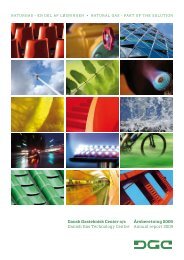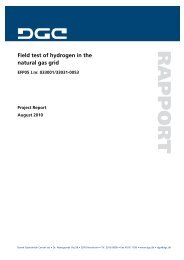Årsberetning - Danish Gas Technology Centre
Årsberetning - Danish Gas Technology Centre
Årsberetning - Danish Gas Technology Centre
Create successful ePaper yourself
Turn your PDF publications into a flip-book with our unique Google optimized e-Paper software.
Kortlægning af mulighederne i<br />
forgasning og SNG<br />
DGC’s bestyrelse iværksatte i 2009 et<br />
strategiforløb for nærmere at undersøge<br />
teknologi, potentiale, økonomi og miljøaspekter<br />
i forbindelse med forgasning, og<br />
resultaterne ser interessante ud:<br />
Hvis man tænker sig, at 10 pct. af den<br />
danske landbrugsjord blev beplantet med<br />
energiafgrøder til fremstilling af SNG fra<br />
forgasning, ville man med de nuværende<br />
dyrkningsteknologier kunne opnå en<br />
energimængde på 40 PJ/år (10 pct. af landbrugsjorden<br />
svarer til de tidligere braklægningsarealer).<br />
40 PJ/år svarer til 25<br />
pct. af det nuværende forbrug af naturgas<br />
i Danmark. Det tekniske potentiale for udbygning<br />
af biogas er ligeledes op til 40 PJ/<br />
år i Danmark. En maksimal udnyttelse af<br />
biogas og biomassebaseret forgasningsgas<br />
ville derfor tilsammen kunne dække 50 pct.<br />
af det nuværende naturgasforbrug.<br />
Med biogas og SNG tilsammen er der altså<br />
et teoretisk potentiale til at erstatte en væsentlig<br />
del af det danske naturgasforbrug<br />
med CO -neutrale energigasser. Danske og<br />
2<br />
udenlandske forgasnings- og SNG-teknologier<br />
er til rådighed, og en del af teknologierne<br />
er demonstreret på kørende anlæg i<br />
Danmark og i udlandet.<br />
SNG – en samfundsøkonomisk gevinst<br />
Alle danske forgasningsprojekter er kendetegnet<br />
ved, at forgasningsprodukterne<br />
anvendes direkte til afbrænding i en efterfølgende<br />
proces, dvs. til en motor eller til<br />
en kedel. I fremtiden med en mulig større<br />
produktion af forgasningsgas fra biomasse<br />
må man forvente, at der er behov for at<br />
omdanne forgasningsgassen til SNG og indføde<br />
den på naturgasnettet på en lignende<br />
måde, som det gøres med biogas.<br />
DGC har gennem hele 2011 arbejdet med<br />
at klarlægge forholdene om styrket brug<br />
af forgasning i Danmark og har senest<br />
udarbejdet de første økonomiske overslag.<br />
De viser, at det for anlæg af en passende<br />
størrelse vil være samfundsøkonomisk<br />
fornuftigt at introducere forgasning i det<br />
danske energisystem.<br />
Forgasningsarbejdet foregår i tæt samarbejde<br />
med Svenskt <strong>Gas</strong>tekniskt Center, som<br />
har et betydeligt engagement på området.<br />
Flere større forgasningsanlæg er under<br />
planlægning eller bygning i Sverige, se<br />
f.eks. www.gobigas.se. DGC vil i 2012 i samarbejde<br />
med DTU gennemføre en detaljeret<br />
undersøgelse af SNG-potentialet i Danmark<br />
og se nærmere på samspillet mellem SNG<br />
og naturgasnettet.<br />
GRØN GAS<br />
31<br />
assessments. The tests showed that<br />
even large volumes of biogas can be<br />
added without problems.<br />
When wood becomes gas<br />
<strong>Gas</strong> can be produced from biomass<br />
(preferably wood) gasification. The<br />
combustible gasification gas is driven<br />
out of the wood using a thermal<br />
process. The gasification gas can<br />
be upgraded so that it is equivalent<br />
to natural gas and is then called<br />
synthetic natural gas or SNG. SNG<br />
from biofuel can be regarded as<br />
fossil-free CO 2 -neutral natural gas.<br />
Mapping the possibilities of<br />
gasification and SNG<br />
In 2009, DGC’s Board of Directors<br />
started a strategic initiative to<br />
study the technology, potential and<br />
financial and environmental aspects<br />
of gasification, and the results look<br />
interesting. If you imagine that 10<br />
per cent of <strong>Danish</strong> agricultural land<br />
were planted with energy crops<br />
to produce SNG from gasification,<br />
it would be possible, with current<br />
cultivation technologies, to achieve<br />
a volume of energy of 40 PJ per<br />
annum (10 per cent of agricultural<br />
land is equivalent to the previous<br />
fallow areas). 40 PJ per annum is<br />
equivalent to 25 per cent of the<br />
current consumption of natural gas<br />
in Denmark. The technical potential<br />
for developing biogas is also up<br />
to 40 PJ per annum in Denmark.<br />
Consequently, maximum utilisation<br />
of biogas and biomass-based gasification<br />
gas would be able to meet<br />
50 per cent of current natural gas<br />
consumption.<br />
With both biogas and SNG, there<br />
is thus theoretical potential to replace<br />
a major part of <strong>Danish</strong> natural<br />
gas consumption with CO 2 -neutral<br />
energy gases. <strong>Danish</strong> and foreign<br />
gasification and SNG technologies<br />
are available, and some of the technologies<br />
are being demonstrated at<br />
operational facilities in Denmark<br />
and abroad.<br />
SNG – a socio-economic benefit<br />
All <strong>Danish</strong> gasification projects<br />
are characterised by the gasification<br />
products being used directly<br />
for combustion in a subsequent<br />
process, i.e. in an engine or a boiler.<br />
In a future with possible higher<br />
production of gasification gas from<br />
biomass, it must be expected that<br />
there will be a need to convert the<br />
gasification gas into SNG and supply<br />
it to the natural gas network in a<br />
similar way to biogas.<br />
Throughout 2011, DGC worked to<br />
clarify the conditions for increased<br />
use of gasification in Denmark. We<br />
have prepared financial estimates<br />
indicating that it would be socioeconomically<br />
beneficial to introduce<br />
gasification into the <strong>Danish</strong> energy<br />
system.





